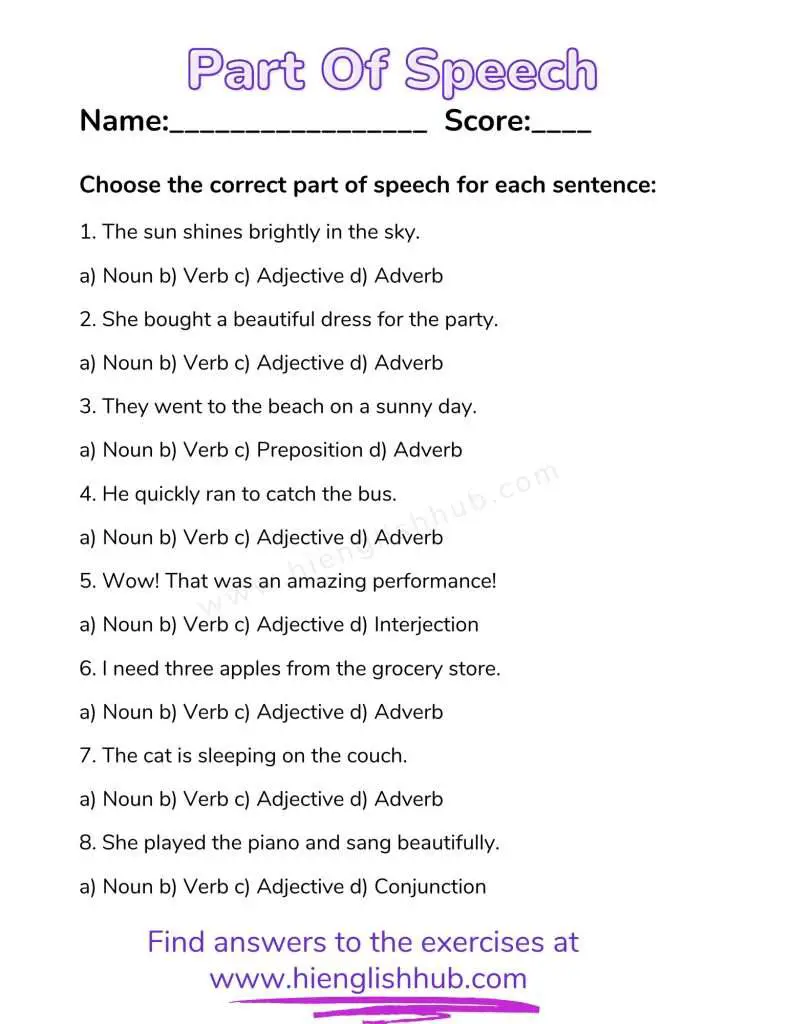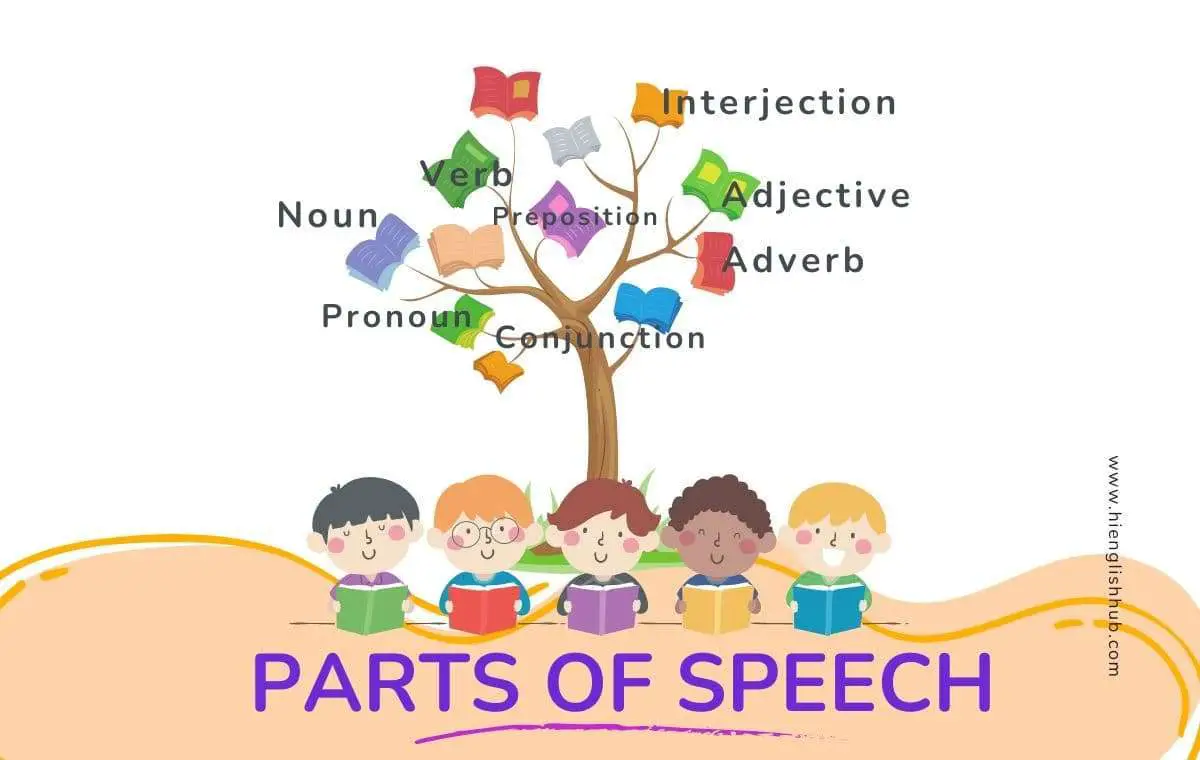Welcome back! In our previous discussion, we delved into the intriguing concept of passive voice. Today, we’re embarking on another captivating adventure.
Ever wondered how words work together to create meaningful sentences?
Well, get excited because we’re about to explore the fascinating world of parts of speech!
We’ll explore the definitions and functions of nouns, verbs, adjectives, adverbs, and more. Along the way, we’ll spice things up with a fun quiz to test your knowledge and keep the learning experience engaging.
So, get ready to unravel the mysteries of language with us!
What Is Part Of Speech?
So, you’re wondering what “parts of speech” are?
It’s kind of like a behind-the-scenes look at how sentences are made.
Every word we use in a sentence has a unique role, sort of like characters in a movie.
Each word’s job is crucial for the sentence to make sense, just like every actor is essential for a movie to come together.
That’s the beauty of “parts of speech.”
Don’t worry, though. We’re about to delve deeper into what these roles are in the following sections.
So, stick around!
8 Parts Of Speech Chart
In traditional English grammar, the eight parts of speech are as follows:
| Part of Speech | Definition | Examples |
|---|---|---|
| Noun | Names a person, place, thing, or idea | Jane, city, time, color |
| Pronoun | Used in place of a noun | he, she, it, they |
| Verb | Expresses an action, occurrence, or state of being | run, eat, is |
| Adjective | Describes or modifies a noun or pronoun | happy, blue, tall |
| Adverb | Describes or modifies a verb, adjective, or other adverbs | quickly, there, very |
| Preposition | Shows a relationship between a noun/pronoun and another | on, in, at |
| Conjunction | Connects words, phrases, or clauses | and, but, or |
| Interjection | Expresses strong emotion or surprise | wow, oh, hey |
| Article | Determines specificity or generalization of a noun | a, an, the |
| Number | Indicates the quantity or position of a noun | one, two, first |
Note: I’ve added two additional parts of speech, article and number.
However, the inclusion of “article” and “number” as distinct parts of speech is not universally agreed upon.
Articles are often considered a type of determiner, which is a subcategory of adjectives.
Number words, such as “one,” “two,” and “first,” can have different roles in a sentence. Depending on their function, they can be categorized as adjectives (e.g., The school has twelve classrooms.), adverbs (e.g., He finished the race first.), nouns (e.g., She knows the number.), or verbs (e.g., Please number the pages).
Part Of Speech Quiz
Here’s a multiple-choice quiz with questions about different parts of speech. Choose the correct part of speech for each sentence:

1. The sun shines brightly in the sky.
a) Noun
b) Verb
c) Adjective
d) Adverb
2. She bought a beautiful dress for the party.
a) Noun
b) Verb
c) Adjective
d) Adverb
3. They went to the beach on a sunny day.
a) Noun
b) Verb
c) Preposition
d) Adverb
4. He quickly ran to catch the bus.
a) Noun
b) Verb
c) Adjective
d) Adverb
5. Wow! That was an amazing performance!
a) Noun
b) Verb
c) Adjective
d) Interjection
6. I need three apples from the grocery store.
a) Noun
b) Verb
c) Adjective
d) Adverb
7. The cat is sleeping on the couch.
a) Noun
b) Verb
c) Adjective
d) Adverb
8. She played the piano and sang beautifully.
a) Noun
b) Verb
c) Adjective
d) Conjunction
Now, let’s go through the answers:
- b) Verb
- c) Adjective
- c) Preposition
- d) Adverb
- d) Interjection
- a) Noun
- b) Verb
- d) Conjunction
FAQs On Part Of Speech
What Part Of Speech Is “The”?
“The” is a definite article. For example, in the sentence “The cat is on the mat,” “the” is used before both “cat” and “mat” to specify which particular cat and mat we’re talking about. It indicates that both the speaker and listener know which cat and which mat are being referred to.
What Part Of Speech Is “In”?
“In” is a preposition. It establishes relationships between objects, indicating location, position, or inclusion. For instance, in the sentence “The cat is hiding in the box,” the word “in” indicates that the cat’s location is within the confines of the box.
The word “in” is primarily used as a preposition in English, but it can also function in other roles, depending on the context:
Adverb: “in” can act as an adverb indicating a state or condition. For example, in the sentence “She is in,” “in” means she is at home or she is at her office.
Adjective: In some cases, “in” can function as an adjective. For example, in the sentence “He has the in knowledge,” “in” describes the type of knowledge that the person has—that is, knowledge that is trendy or popular.
Part of a phrasal verb: “in” can also be used as part of a phrasal verb, which is a verb made up of two or three words. An example is “break in,” as in “He had to break in his new shoes.” Here, “in” helps to change the meaning of the verb “break.”
What Part Of Speech Is “Is”?
“Is” is a verb. Specifically, it is a form of the verb “to be,” which is used to describe a state of being or existence. For example, in the sentence “She is a teacher,” “is” is the verb linking the subject “She” to the complement “a teacher.”
What Part Of Speech Is “And”?
“And” is a conjunction. Conjunctions are words that connect or link words, phrases, or clauses together in a sentence. The word “and” is specifically known as a coordinating conjunction, as it joins together elements of equal grammatical rank, like two nouns, two verbs, two adjectives, two phrases, or two independent clauses.
What Part Of Speech Is “With”?
“With” is a preposition. It helps to show the relationships between the linked words. The word “with” often indicates association, accompaniment, or means/methods. For example, in the sentence “I’m going to the park with my friend,” “with” is the preposition linking “I’m going to the park” to “my friend.”
What Part Of Speech Is “My”?
“My” is considered a possessive adjective in English. It’s used to show ownership or association with a noun, as in “my book” or “my house”.
What Is An Example Of A Conjunction?
An example of a conjunction is “but”. It’s used to connect words, phrases, or clauses that contrast with each other, as in “I wanted to go for a run, but it was raining.”
Which Are Interjections?
Interjections are words or phrases that express strong emotion or surprise. Examples of interjections include “Oh!”, “Wow!”, “Oops!”, “Ugh!”, and “Hey!”.
Wrapping Up
I hope you enjoyed our journey through the fascinating realm of parts of speech!
From nouns to verbs, adjectives to adverbs, you’ve gained valuable insights into how words bring language to life.
Remember to put your knowledge into practice by analyzing sentences and spotting the different parts of speech.
And hey, don’t forget to share this blog post with your friends or anyone who might find it helpful.
Also, be sure to follow Hi English Hub on Pinterest and Twitter for more exciting language tips and resources.
Keep exploring, keep learning, and keep mastering the beauty of words!

